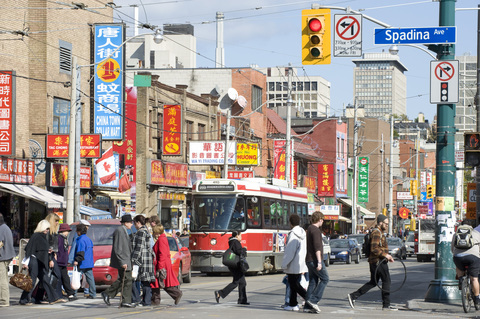David Suzuki's Blog, page 15
March 7, 2017
What we measure affects what we do

(Credit: Laura Berman)
"What we measure affects what we do. If we have the wrong metrics, we will strive for the wrong things" -- a prescient observation made by Joseph Stiglitz, Nobel Prize winner and former chief economist for the World Bank. What we're measuring got a bit clearer in Canada with the recent release of the Ecosystem Services Toolkit. This toolkit will help assess the benefits that ecosystems provide to people, communities and economies, and encourage factoring the diverse values of ecosystems into decisions. While the toolkit is designed for managers and analysts, the ecosystem services that are assessed provide a plethora of benefits to all people in Canada, regardless of where they live.
This interdisciplinary approach integrates science, economics and traditional knowledge. The toolkit incorporates ecosystem services analysis in areas such as environmental assessments, cost-benefit analysis and wildlife management. It provides a more comprehensive measure of well-being, which allows us to know whether our ecosystems are healthy or not and better manage them in the long-term. If we factor nature into decision-making, we can help conserve it as a green asset into the future, just as we do other forms of capital. A good accountant would never ignore the depreciation of a country's capital, yet our standard measures (e.g., GDP) fail to take resource depletion and environmental degradation into account.
I provided feedback for this toolkit and am excited about the possibilities of its uptake across the country in rural, urban and other settings. It is urgent that we shift our approach without delay. Growing human populations and increasing urbanization are intensifying demands on ecosystems and placing ecosystem services at greater risk. Due to the complex nature of ecosystem services, the more comprehensive approach detailed in this toolkit is needed when making decisions that affect ecosystems and their services.
Why is this so important? Because ecosystem services provide life-support (e.g., clean air, water and food), security (e.g., mitigating extreme weather events associated with climate change) and quality of life (e.g., cultural identity, recreation). The UN Millennium Ecosystem Assessment reviewed the condition of ecosystems and their services around the world and how they benefit human well-being. It found that, over the past 50 years, humans have changed ecosystems more rapidly and extensively than in any comparable period of time in human history, largely to meet rapidly growing demands for food, fresh water, timber, fibre and fuel. This has resulted in a substantial, largely irreversible loss in the diversity of life on Earth.
It's time to change our relationship with nature. Making nature count may be one of the most effective ways to do this.
Hey! Want more DSF? Join David Suzuki on Facebook

March 6, 2017
House of Commons committee to open hearings on neonic pesticide with industry-biased panel
11th-hour invitation to testify issued to coalition of NGOs pressing government to proceed with proposed phase-out to protect biodiversity and long-term food security
OTTAWA - Leading environmental groups, health advocates and campaign movements are raising concerns about MPs' one-sided review of the proposed phase-out of pesticides formulated with imidacloprid, one of three controversial neonicotinoid insecticides ("neonics") in widespread use. Canada's Pest Management Regulatory Agency (PMRA) has proposed to phase out the main uses of imidacloprid in three to five years, after an environmental assessment found dangerous levels of the chemical contaminating the environment.
The House of Commons Standing Committee on Agriculture and Agri-Food requested an extension to the comment period in order to study the proposal, with hearings beginning Tuesday. The notice posted on the committee website for Tuesday's meeting lists CropLife Canada (the pesticide industry trade association), along with Syngenta Canada and Bayer CropScience Inc. (manufacturers of neonic pesticides) as witnesses. Representatives of the PMRA and Agriculture Canada are also scheduled to appear. Environment and Climate Change Canada is not listed as a witness. None of the groups issuing this release were originally invited to testify before the committee. Approximately one hour after distribution of the original draft of this release, the David Suzuki Foundation received an invitation to testify.
"It appears the committee has given centre stage to industry lobby groups opposed to restrictions on pesticides. It is troubling that environmental concerns are clearly an afterthought," said Sidney Ribaux, executive director of Équiterre.
"Independent scientists warn that the widespread use of neonics threatens many species," said Lisa Gue, senior researcher and policy analyst with the David Suzuki Foundation. "We urge the PMRA to confirm its decision to phase out imidacloprid, tighten the timeline and take parallel action to ban other neonics."
"There has been an overwhelming flood of public support for Canada's proposal to ban one of the most harmful neonics," said Liz McDowell, campaign director with SumOfUs. "People understand that the routine use of these chemicals is not necessary or sustainable, and they don't want to see industry lobbyists weakening such an important measure."
More than five million people -- including hundreds of thousands of Canadians -- have signed Avaaz and SumOfUs petitions calling for neonics to be banned, and more than 110,000 Canadians and counting have submitted individual public comments to the PMRA in support of a ban on imidacloprid.
Mass die-offs of honeybees linked to the agricultural use of neonics prompted researchers and regulators around the world to re-examine the pesticides in recent years. In 2015, the Task Force on Systemic Pesticides -- an international group of independent scientists -- reviewed more than 1,000 scientific studies on neonics and found clear evidence of harm to honeybees and other pollinators, terrestrial invertebrates such as earthworms, aquatic invertebrates and birds. The Task Force sounded the alarm about these pesticides destroying ecological services, such as pollination, which are essential for long-term food security. Emerging research indicates that neonics and their residues may harm human health.
The European Union has a partial ban on three neonics, including imidacloprid, and France recently passed a law banning neonics altogether as of September 2018.
Canada's PMRA re-evaluated imidacloprid last year and concluded that its current use is not sustainable on the basis of risks to aquatic ecosystems. The environmental assessment found imidacloprid present in Canadian lakes and rivers at levels that are harmful to aquatic insects essential to the health of aquatic ecosystems. This assessment did not consider risks to pollinators, which the PMRA has been evaluating through a separate process with the U.S. Environmental Protection Agency (EPA) since 2012.
"We would prefer swifter action to stop imidacloprid from entering the environment," said John Bennett of Friends of the Earth Canada. "There is no scientific justification for another three to five years on the market."
Avaaz campaign director Danny Auron said, "This chemical is a threat to our delicate web of life, from aquatic insects to bees and birds. That's why millions of people are urging the government to put bees, people and the environment ahead of toxic corporate interests."
The PMRA will consult on the proposed phase-out of imidacloprid until March 23, 2017, and will issue a final decision later this year.
- 30 -
Distributed on behalf of the following groups:
· David Suzuki Foundation
· Avaaz
· SumOfUs
· Équiterre
· Friends of the Earth
· Canadian Environmental Law Association
· Environmental Defence
· Prevent Cancer Now
· Alliance pour l'interdiction des pesticides systémiques
· Canadian Association of Physicians for the Environment (CAPE)
For more information or to arrange an interview, please contact:
Brendan Glauser, David Suzuki Foundation, 604-356-8829, bglauser@davidsuzuki.org
Ari Pottens, Avaaz, 647 209 9799, ari@avaaz.org
Liz McDowell, SumOfUs, 604-219-6337, liz@sumofus.org
Julie Tremblay, Équiterre, 514-522-2000 × 311 | 514-966-6992, jtremblay@equiterre.org
John Bennett, Friends of the Earth, 613-291-6888, johnbennett@foecanada.org
Kathleen Cooper, Canadian Environmental Law Association, 705-341-2488, kcooper@cela.ca
Muhannad Malas, Environmental Defence, 416-323-9521 ext. 241, mmalas@environmentaldefence.ca
Meg Sears, Prevent Cancer Now, 613 297-6042, meg@preventcancernow.ca
Kim Perrotta, Canadian Association of Physicians for the Environment (CAPE), 905-628-9437 kim@cape.ca
Hey! Want more DSF? Join David Suzuki on Facebook

March 2, 2017
Greatness comes from moving forward, not backward

(Credit: David Ingram via Flickr)
The battle lines are drawn -- in some cases literally. On one side are those reaping massive profits from fossil fuels, determined to extract and sell as much as possible before the market dries up. On the other are those who see the amazing potential of energy conservation, renewable energy and other innovations to reduce pollution, greenhouse gas emissions, ecosystem destruction and exploitation of valuable non-renewable resources.
Despite international initiatives like the 2015 Paris Agreement, based on decades of research and evidence from around the world about human-caused global warming, those who would risk human health and survival for short-term profits from a destructive sunset industry appear to have the upper hand -- for now. The election of a U.S. president and vice-president who deny the very existence of anthropogenic climate change and who have appointed likeminded people and industry executives to key positions illustrates how entrenched those committed to outdated, albeit still profitable, energy sources and technologies are.
Literal battles are heating up, such as at Standing Rock in the U.S., where the Sioux and their allies have been fighting to protect water resources and sacred sites from the 1,886-kilometre Dakota Access pipeline, which would transport crude oil from North Dakota to a refinery in Illinois, under lakes and rivers, barely skirting Sioux territory.
Ideological battles are also heating up. Fossil fuel interests have long spent buckets of money to spread false and misleading information to downplay or deny the seriousness of climate change, aided by politicians, armies of online trolls and shady organizations and "think tanks." The new U.S. administration has emboldened them further.
Unfortunately, those who believe we should continue to burn polluting, climate-altering, non-renewable fuels are bolstered by an abundance of resources: lots of money, secretly funded climate science-denial organizations, complacent media outlets and unethical politicians. Those of us who care about a safer, healthier future have our work cut out.
We also have a lot going for us. Despite the U.S. president's promises, no one is going back to mining and burning massive amounts of coal. Making America -- or any place -- great doesn't mean embracing 18th century technology in the 21st. That would be worse than if President Theodore Roosevelt had kicked the Ford Motor Company to the curb to keep the horse-and-buggy industry going!
Whatever greatness America can claim has largely been the result of government and society embracing science, technology and great ideas, from putting people on the moon to conserving some of the world's most spectacular pristine places in its national parks system. Many of today's political representatives and their fossil fuel cronies don't seem to get that. But others do. Some, like Tesla's Elon Musk, are developing clean power and storage technologies that are rendering fossil fuels obsolete.
Technological advances have made wind and solar cost-competitive, and the sector is growing rapidly. The U.S. Energy Department says the solar power industry alone employed almost twice as many people in electric power generation in 2016 as coal, oil and gas combined -- 43 per cent compared to 22 per cent for fossil fuels. Meanwhile, coal-fired plants have dropped from supplying half the U.S.'s energy in 2008 to 30 per cent in 2016. Consumer electricity costs have also dropped significantly over the past year. Other countries and jurisdictions, including some U.S. states, are rapidly shifting from fossil fuels to clean energy, creating good jobs and economic opportunities.
Meanwhile, tensions around dwindling fossil fuel reserves -- from Standing Rock to the Middle East -- are increasing. People demanding change are coming together in massive marches and protests worldwide. Any administration that continues to support destructive energy-generating methods developed hundreds of years ago when consequences weren't well understood, populations were smaller and conditions were different, will get left behind as the rest of the world prospers from new ideas and technologies.
It's hard to fathom that so many people, especially in positions of power, can't see the many benefits of science and technological progress. It wouldn't be a battle if everyone accepted that clean air, fresh water, healthy agricultural soils and diverse ecosystems are critical to human health and survival.
There's still time to get humanity on track, but in the face of powerful opponents who reject science and changes that improve people's lives, there's no time for complacency.
Hey! Want more DSF? Join David Suzuki on Facebook

March 1, 2017
What we can do to connect people, schools and the community to address climate change

Credit: Rachel Irving-Hughes (Kew Beach coop member and parent)
Bob Spencer is proud of the 72-kilowatt solar array on an elementary school in Toronto's Beach neighbourhood. "It was a world speed record," he jokes. "They created the array in just 22 days."
Spencer, a former school trustee and founder of the grassroots energy co-op commissioned to install the solar panels, explains, "It was built between August 11 and September 2, 2016."
Its genesis was a question the Spencers and two other Beach families asked themselves almost a decade ago: "What can we do to connect people, schools and the community to address climate change?" They settled on the idea of turning Kew Beach public school, which their kids attended, into an electricity generator.
Over time, Spencer pulled together dozens of like-minded locals and created the Beach Community Energy Co-op, incorporated in 2012. He believes the organization's structure as a co-operative has been central to its success and points to a survey conducted by a Kew Beach teacher that found community support for the solar panels at 85 per cent. "There's something about a co-op," Spencer says. "You have to build consensus to move forward. You have to convince a lot of people to agree with you."
Funding the project wasn't simple. Bullfrog Power put in $25,000 -- "right at the point we were about to give up!" Spencer says -- with half the overall capital coming from crowd sourcing and the other half from a bond offering. Notwithstanding the difficulties, Spencer is proud that the money came from local folks. "We did it with 150 community members and one local business."
An energy activist since the 1970s, he's motivated by a desire to move his province away from nuclear energy, a direction he sees as viable. "Ontario has 4,000 schools; almost none have solar on them. But parents and communities united can build solar and get us off nuclear. That's my personal excitement."
Beyond their wider environmental value, the panels have a host of benefits for the school. Placing them on a roof can start, sometimes subtly, to shift an institution's culture. "Solar arrays organically build an ecological consciousness among kids, parents and staff," Spencer says. He makes the audacious claim that photovoltaics' presence can alter the very words students use to describe their future. They come to frame it in sanguine terms. "When you do solar arrays, people's language changes, so the discourse becomes positive about tomorrow." The technology isn't neutral; it has an embedded optimism and, when deployed in educational settings, spurs an ethos of hopefulness.
Spencer's vision is broad: he wants school-top arrays to serve whole neighbourhoods. He suggests the Kew Beach site could provide electricity for nearby condos on Toronto's Queen Street East. This would raise significant funds for the school board -- the energy co-op pays rent for use of the roof -- and help decentralize the province's power production, making it more resilient.
The desire for Ontario to part company with large, centralized generators -- particularly nuclear ones -- is never far from Spencer's mind. Today he sees this possibility as especially close. The economics work and the co-op model suggests a plausible route for the transition.
"Renewables are now just about the same cost as nuclear," he says with satisfaction. "The tipping point has arrived."
Hey! Want more DSF? Join David Suzuki on Facebook

February 28, 2017
Help end forced child labour: Choose fair trade goods

Many people know to look for fair trade chocolate, coffee, tea and bananas. But you can also try fair trade lip balm, flowers, clothing and sport equipment! (Credit: Lindsay Coulter)
In an ideal world, stores would only carry goods that are healthy for people and the planet. Until then, we must read labels and choose with care.
What does fair trade mean?
Fair trade helps promote sustainable agriculture around the world. Farmers are paid for what they grow based on internationally recognized standards on wages, labour rights, working conditions and prices. The practice supports farming co-ops, housing, and health and safety standards. Fair trade also means no child labour (workers under the age of 15, as defined by the International Labour Organization).
The dollars you spend on fair trade products allow children to go to school, provide safer working condition and help communities thrive. The fair trade certification system also prohibits GMOs and limits the use of agrochemicals.
What fair trade products can I buy?
Coffee: It's the second most traded commodity on Earth after oil! Growers have cleared millions of acres of land worldwide. They often use toxic pesticides and GMO varieties to increase production. Songbirds that summer in Canada usually spend winters in coffee-growing latitudes. Our coffee habits threaten a lot of their habitat! Help birds and other species. Choose coffee that has been triple-certified: fair trade, organic and shade-grown.
Chocolate: Growers of cocoa -- the chocolate bean -- have also cleared millions of acres worldwide, evicting forest inhabitants, including boreal birds. The ILO (and others) report widespread child slavery on many cocoa farms in the Ivory Coast. In sub-Saharan Africa, 30 per cent of children under age 15 are labourers, often in agricultural activities. Avoid the bitterest side of chocolate -- human trafficking or slavery. Choose certified fair trade chocolate.
Flowers: A conventional floral bouquet may be grown by children in a country far away, under nasty, pesticide-laden working conditions. Not a nice way to say "I care!" Plant seeds for long-lasting happiness. Choose fair-trade flowers or potted plants that restrict certain agrochemicals, pay fair wages (often double the standard) and avoid child labour.
Clothing: The opposite of fair trade threads is fast fashion that entices us to buy more for less. But cheap clothing and accessories are no bargain. They're not made to last. And low-priced items are more likely to contain lead -- beware of bright and shiny handbags and wallets. Beading and sequins are a good indicator of child labour.
In Magnifeco: your head-to-toe guide to ethical fashion and non-toxic beauty, Kate Black says that when we pay less, we also get less: less transparency and accountability, and lower ethical standards and quality. Fair trade clothing brands commit to worker well-being, fair prices to suppliers, transparency, accountability, economic opportunities, no forced labour, respect for the environment (e.g., organic or low-pesticide production) and more.
Sports balls: Choose certified fair trade soccer balls, volleyballs (indoor and beach) and basketballs! These balls are made to last, hand-stitched (instead of machine-stitched) and PVC-free. Manufacturers must meet certain social, economic (e.g., fair wages) and environmental standards. Fair trade premiums contribute toward programs that help employees and their families, such as eye exams, diabetes tests, school supplies and clean drinking water for schools.
Watch for these two labels:
Fairtrade International (green, black and blue logo), a group of 25 organizations, certifies international fair trade standards that address the imbalance of power in trading relationships, unstable markets and the injustices of conventional trade. They connect disadvantaged producers to consumers, promote fairer trading conditions and empower producers to combat poverty and take more control over their lives.
Fair Trade Canada and Fair Trade USA (black, white and green logo) are leading third-party certifiers of fair trade products. They uses a market-based approach that gives farmers fair prices, workers safe conditions, and entire communities resources for fair, healthy and sustainable lives.
Make informed decisions to reduce your environmental footprint. Understand labels and claims found on everyday products. Search for certified eco-labels such as fair trade. You'll be a sustainable shopper. And you'll empower and help people around the world.
Sincerely,
Lindsay Coulter a fellow Queen of Green
Hey! Want more DSF? Join David Suzuki on Facebook

February 23, 2017
Marvelous monarchs move Minister McKenna

(Credit: Jode Roberts)
Federal Environment and Climate Change Minister Catherine McKenna had her mind blown recently. Remarkably, it had nothing to do with the political gong show south of the border. McKenna was visiting the hilltop monarch butterfly reserves in rural Mexico. There she saw millions of monarchs clinging to oyamel fir trees in mind-bogglingly dense clusters, surprisingly well-camouflaged for such colourful critters. She then wrote a heartfelt article calling on people in Canada to act before monarchs go the way of passenger pigeons and buffalo.
Those monarchs travel thousands of kilometres, many from summer breeding grounds in Canada that once stretched from southern Saskatchewan to the Maritimes. As a child growing up in southwestern Ontario, I collected insects. Monarchs were abundant everywhere. The mass exodus through Point Pelee at summer's end was mesmerizing.
That's changed. Since the 1990s, the eastern monarch population has declined by about 90 per cent. More than a billion monarchs once made the journey to Mexico. In winter 2013, that dropped to 35 million. Modest increases since then have largely been erased. An intense late-winter storm wiped out more than six million monarchs last March and unfavourable weather conditions during critical breeding periods caused a 27 per cent reduction over the past year.
Much of the overall decline has been pinned on the eradication of milkweed through widespread use of the herbicide glyphosate (known as Roundup) in the U.S. Midwest and southern Canada. Milkweed is a host plant and the only food source for monarch caterpillars. Extreme weather conditions -- including extended droughts during critical breeding periods and severe winter storms in Mexico that topple trees and cause mudslides in forests where monarchs overwinter -- have exacerbated the decline.
In 2016, scientists estimated the monarch population has up to a 57 per cent chance of "quasi-extinction" over the next 20 years. That means the population could hit levels so low recovery is impossible. Others suggest the migration into Canada could end. In November, scientists overseeing at-risk species in Canada said the government should list the monarch butterfly population as endangered.
So, what's happening? The minister's own assessment is telling. In her article, she cites only a fledgling citizen science project as the most notable progress here since leaders of Canada, the U.S. and Mexico began seriously contemplating action in 2014. I would add dozens of great local programs, like the David Suzuki Foundation's Homegrown National Park Project and Got Milkweed campaign, which have inspired people to plant thousands of milkweed and other pollinator-friendly wildflowers. Municipalities like the City of Markham have taken the lead, committing to become more monarch-friendly by planting milkweed on public lands. Exciting new programs like the Butterflyway Project will spur neighbourhood-scale butterfly- and bee-friendly corridors in five cities this year.
But municipal and citizen-led programs are not enough. Pre-eminent monarch advocate Chip Taylor estimates that more than a billion milkweed will need to be planted throughout the range if the population is to recover. That would require unprecedented co-operation and collaboration by agencies, groups and scientists throughout the monarch's 5,000-kilometre migratory route, especially in the northern end of the range where 44 per cent of the population originates, according to University of Guelph scientists.
In the U.S., plans have taken flight over the past few years. Federal and state agencies collaborated to develop an ambitious 10-year plan to increase the monarch population, providing more than $10 million for research and conservation efforts. Former president Barack Obama helped launch a plan to establish one million bee- and butterfly-friendly gardens across the continent, including butterfly gardens on the White House grounds.
In Mexico, government agencies, international organizations and local groups like Alternare are working diligently to protect the forests where monarchs overwinter.
What's missing is action from Canada's government. The good news is that the person with the most power to influence the plight of this imperilled species is Minister McKenna. Whether Canada legally protects monarchs, as recommended in November by federal scientists, is up to her. Whether funds flow to monarch and pollinator research and conservation programs is largely her ministry's responsibility. That's why her newfound love of monarchs renews my hope.
If Canada is serious about saving the monarchs, the federal government needs to start now.
Hey! Want more DSF? Join David Suzuki on Facebook

February 21, 2017
B.C. budget falls short on critical transit investment and climate action
VANCOUVER -- The B.C. government has failed to prioritize badly needed transit infrastructure investment in its latest budget. Based on details provided, investment over the next three years will continue to fall short of what Metro Vancouver and the province need to build and maintain fast, effective public transit.
"Anticipated budget surpluses over the next three years are dwarfed by the growing costs of congestion in B.C.," said David Suzuki Foundation policy analyst Steve Kux. "Traffic congestion costs Metro Vancouver alone over $1 billion a year -- and that's expected to balloon to $2 billion by 2045. Failing to commit to increased investment in transit is a missed opportunity no matter how you look at it."
Kux emphasized that this is a critical moment for the province to follow the federal government's lead on infrastructure improvement.
In November 2016, the federal government committed to provide $25.3 billion for public transit infrastructure projects across the country over the next 11 years, including up to 50 per cent of funds needed for specific projects. However, to secure this investment, provincial and municipal governments have to cooperate to produce the remaining 50 per cent.
"The B.C. government has only committed to a fraction of the funding needed to achieve the needed transit improvements across Metro Vancouver, the province's most congested region," Kux said. "Instead of pledging a fair share of investment, the B.C. government has prioritized tax cuts that will benefit the wealthiest British Columbians most and give financial protections to polluting industries like liquefied natural gas. This lack of investment will lead to costly delays in improvements that are needed today."
In Breaking gridlock, the Foundation's 2016 report on B.C.'s transit investment deficit, Kux and Foundation science and policy director Ian Bruce found the government has underfunded transit since 2008. Eight years into the 12-year Provincial Transit Plan, only 23 per cent of the provincial contributions have been realized.
The budget also falls short on reducing carbon emissions. Although it provides a $40 million top-up to the Clean Energy Vehicle Program, it fails to strengthen the province's carbon tax and focuses more attention on financial incentives for fracked natural gas, which is a major contributor to climate change.
"The province continues to pin its hopes on LNG and new hydro projects at the expense of innovation and supporting job growth in areas like clean tech," Kux said. "Clean energy organizations are leaving this province, and we're falling behind the rest of the country and the world."
The Canadian Wind Energy Association shut down its B.C. operations last year, citing better opportunities in Alberta and Saskatchewan. Other low-carbon, job-creating industries could follow if B.C. does not commit to help transition the world off of fossil fuels.
30
Media contact:
Emily Fister, Communications Specialist - 604-440-5470
Hey! Want more DSF? Join David Suzuki on Facebook

Clean water for all!

The federal government promised to end drinking water advisories in First Nations within five years of being elected. Our research shows the government is not on track to fulfil its commitment.
Let's stand together to ensure that the federal government lives up to its promise to end the drinking water crisis in First Nations communities by 2020.
Hey! Want more DSF? Join David Suzuki on Facebook

February 20, 2017
Canadian environment ministers must protect caribou habitat
TORONTO -- Conservation groups are calling on federal, provincial and territorial environment ministers to act quickly to recover Canada's imperilled woodland caribou herds through habitat measures. The call comes in advance of the environment ministers' meeting in Ottawa February 21 to 22.
It has been almost five years since the federal government released the boreal woodland caribou recovery strategy under the Species at Risk Act (SARA). The strategy developed a threshold of risk for managing caribou, and guides provinces to maintain or restore each caribou range so that at least 65 per cent of it is undisturbed, as caribou need undisturbed habitat to avoid predators and survive. The recovery strategy calls for range plans to be completed by October 2017 that demonstrate the protection, maintenance and restoration of caribou habitat for each caribou herd.
Yet, across Canada, industrial activities such as mining, oil and gas and logging continue to disturb critical caribou habitat. For example, even though the habitat of west central Alberta's Little Smoky range is over 95 per cent disturbed, the province released a draft range plan that allows new logging and oil and gas surface disturbance. In Ontario and Quebec, logging continues to degrade intact caribou habitat.
A recent article in Biological Conservation concluded that Canada will likely lose more than half its woodland caribou populations within a few decades unless habitat conservation measures are improved -- especially in Western Canada where energy industry activity is heavy.
"Clear science exists to guide caribou recovery, yet we continue to see provinces allowing habitat destruction while engaging in band-aid solutions such as predator control and zoo-like enclosures," said Rachel Plotkin of the David Suzuki Foundation "If we are to have wild caribou in the future, habitat protection and restoration need to be kicked to the top of the action list."
Conservation groups believe the economy can work for both caribou and industry. Tenure and lease systems can be realigned to reduce pressure on critical caribou habitat, some activities can be confined to existing disturbed areas, and restoration initiatives can be implemented in areas where habitat has already exceeded disturbance thresholds.
Protection and restoration of caribou habitat will have impacts beyond caribou recovery; the boreal forest on which caribou depend stores significant carbon and provides homes and resting places for hundreds of other species, such as migratory birds.
"To uphold our wildlife laws and commitments, provinces need to enforce limits on surface disturbance within caribou ranges," said Alberta Wilderness Association conservation specialist Carolyn Campbell. "They also need to follow important protected-areas promises with actions."
"Protecting caribou is synonymous with a healthy Boreal forest. We have the knowledge and capacity to be good stewards - we can protect our wildlife and have sustainable forest industries, too," said Greenpeace forest campaigner, Olivier Kolmel. "The government must act now, because soon it will simply be too late."
30
For more information, please read the media backgrounder or contact:
Carolyn Campbell, Alberta Wilderness Association: 403 921-9519.
Rachel Plotkin, David Suzuki Foundation: 416 799-8435
Manon Dubois (French): 514 679-0821
Hey! Want more DSF? Join David Suzuki on Facebook

February 17, 2017
Municipal vehicle tax could fund transit, benefit all city-dwellers

(Credit: City of Toronto via Flickr)
Now that road tolls are out, at least for the foreseeable future, how can Toronto pay for public transit that is vital to our climate goals and congestion relief?
One approach is to reinstate the personal vehicle tax that was killed during the reign of Mayor Ford. Few of us have nostalgia for that era, and bringing back a useful revenue tool the city wrongly trashed could help put this unfortunate period behind us.
Owners would pay the PVT when they register personal, but not commercial, vehicles, including cars, motorcycles and mopeds. (Drivers in the latter categories would pay a lower rate.)
The amount charged would be up to city council, but would likely be modest, around $60 to $100 annually. Some car owners might complain, but this is a fraction of the approximately $1,000 per year they would have paid to drive on the city's expressways under a tolling regime.
Levying a vehicle tax would bring Toronto in line with other major municipalities that already collect it and enjoy a dedicated revenue stream for vital services. Montreal car owners, for example, pay an annual $75 fee, which the city uses to support public transit. Drivers in Chicago pay a yearly "wheel tax" of about US$86, which helps to repair and maintain local roads.
These smart communities know that funding essential programs requires a suite of revenue tools beyond property taxes.
A PVT would offer the city many benefits:
1) It could incentivize less-polluting cars. As KPMG explains in its City of Toronto Revenue Options Study, this tax "can be customized to price discriminate across different types, ages, and classes of vehicles to help drive policy objectives such as encouraging the use of fuel efficient vehicles." We know that transportation is now the main source of greenhouse gases in Ontario; getting inefficient cars off the road could help the city meet its climate change targets. Council should consider waiving the PVT for hybrids and electric vehicles.
2) It's quick, easy money. In their paper, "More Tax Sources for Canada's Largest Cities: Why, What, and How?" municipal finance experts Harry Kitchen and Enid Slack argue a vehicle registration levy is "inexpensive to implement and administer." One reason: The city could collect it through an existing system the province uses to handle its own registration fee. Ease of implementation means it could be running in short order. The City of Toronto estimates it could be in place by April 1. Of 12 revenue tools KPMG examined, the vehicle tax would be the fastest to bring in. Because it's permitted under the City of Toronto Act, it would face no legislative hurdles and we could start enjoying its benefits, in terms of improved services, in just a few months.
3) It would generate substantial dollars for vital services. If the annual fee were $60, KPMG estimates the city would net $55.7 million. If the fee were $100, it would net $93.5 million. Even at the lower end, this is a significant revenue source. For example, the Toronto transit system's recent fare increase will bring in an estimated $27 million. That fare hike -- which is especially difficult for low-income transit users -- could have been entirely avoided had a PVT been in place.
4) It won't be onerous for drivers. KPMG says the cost of owning and operating a vehicle is about $11,000 a year. If the PVT were $100, it would represent less than one per cent of this yearly expense.
Road tolls are an excellent idea but they're not likely to be implemented any time soon. In the interim, the city should bring back a small PVT earmarked for transit.
One unfortunate legacy of the Ford era is the suggestion that fees paid by drivers represent a "war on cars". It's time to discard this nonsense and realize that a tax dedicated to transit improvement -- which helps residents leave the automobile at home -- is also a boon to motorists. After all, buses, subways and light rail are tremendous allies in the effort to beat congestion.
Hey! Want more DSF? Join David Suzuki on Facebook

David Suzuki's Blog
- David Suzuki's profile
- 247 followers



